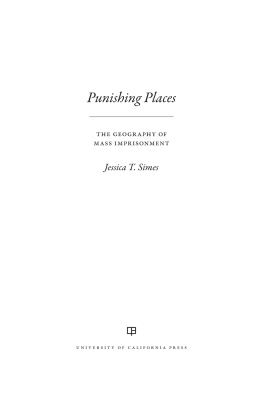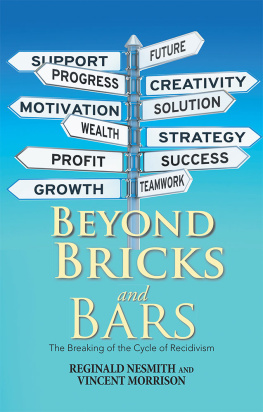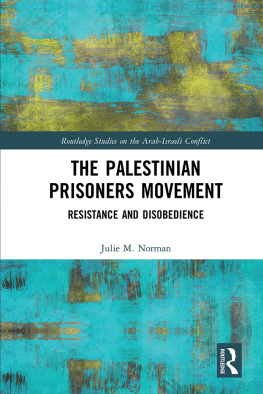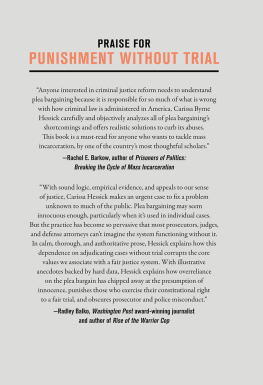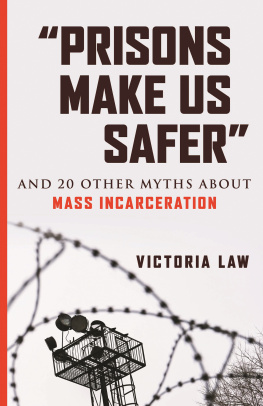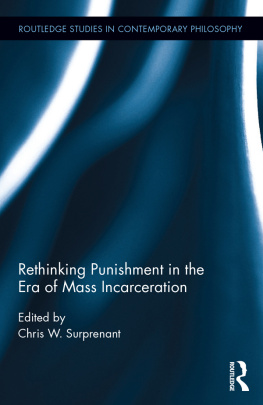Rachel Elise Barkow - Prisoners of Politics: Breaking the Cycle of Mass Incarceration
Here you can read online Rachel Elise Barkow - Prisoners of Politics: Breaking the Cycle of Mass Incarceration full text of the book (entire story) in english for free. Download pdf and epub, get meaning, cover and reviews about this ebook. publisher: Harvard University Press, genre: Politics. Description of the work, (preface) as well as reviews are available. Best literature library LitArk.com created for fans of good reading and offers a wide selection of genres:
Romance novel
Science fiction
Adventure
Detective
Science
History
Home and family
Prose
Art
Politics
Computer
Non-fiction
Religion
Business
Children
Humor
Choose a favorite category and find really read worthwhile books. Enjoy immersion in the world of imagination, feel the emotions of the characters or learn something new for yourself, make an fascinating discovery.

- Book:Prisoners of Politics: Breaking the Cycle of Mass Incarceration
- Author:
- Publisher:Harvard University Press
- Genre:
- Rating:5 / 5
- Favourites:Add to favourites
- Your mark:
- 100
- 1
- 2
- 3
- 4
- 5
Prisoners of Politics: Breaking the Cycle of Mass Incarceration: summary, description and annotation
We offer to read an annotation, description, summary or preface (depends on what the author of the book "Prisoners of Politics: Breaking the Cycle of Mass Incarceration" wrote himself). If you haven't found the necessary information about the book — write in the comments, we will try to find it.
Prisoners of Politics: Breaking the Cycle of Mass Incarceration — read online for free the complete book (whole text) full work
Below is the text of the book, divided by pages. System saving the place of the last page read, allows you to conveniently read the book "Prisoners of Politics: Breaking the Cycle of Mass Incarceration" online for free, without having to search again every time where you left off. Put a bookmark, and you can go to the page where you finished reading at any time.
Font size:
Interval:
Bookmark:
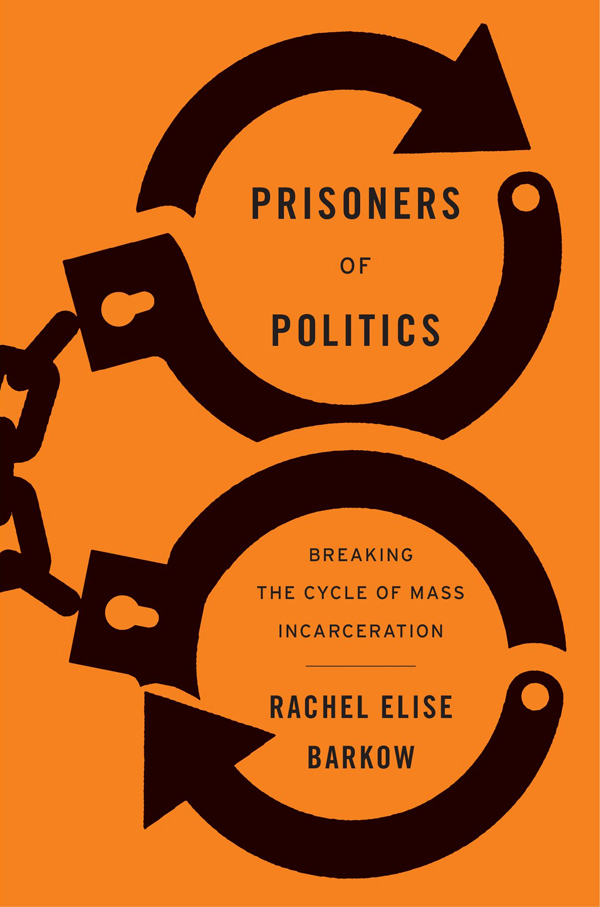
PRISONERS OF POLITICS
Breaking the Cycle of Mass Incarceration
RACHEL ELISE BARKOW


THE BELKNAP PRESS OF HARVARD UNIVERSITY PRESS
Cambridge, Massachusetts
London, England
2019
Copyright 2019 by the President and Fellows of Harvard College
All rights reserved
Cover design: Graciela Galup
Cover art: Getty Images
978-0-674-91923-5 (alk. paper)
978-0-674-23901-2 (EPUB)
978-0-674-23902-9 (MOBI)
978-0-674-23899-2 (PDF)
The Library of Congress has cataloged the printed edition as follows:
Names: Barkow, Rachel E., author.
Title: Prisoners of politics : breaking the cycle of mass incarceration / Rachel Elise Barkow.
Description: Cambridge, Massachusetts : The Belknap Press of Harvard University Press, 2019. | Includes bibliographical references and index.
Identifiers: LCCN 2018032017
Subjects: LCSH: Criminal justice, Administration ofUnited States. | Criminal justice, Administration ofPlanningUnited States.
Classification: LCC HV9950 .B358 2019 | DDC 365/.70973dc23
LC record available at https://lccn.loc.gov/2018032017
For Nate,
whose love and encouragement are behind every word in this book and whose kind and generous heart keeps me hopeful for a better future
FEW PEOPLE WOULD want to establish air pollutant limits or workplace safety conditions by popular vote. Instead, most people prefer to trust experts with specialized knowledge to set policies based on studies of what maximizes public safety and an analysis of the costs and benefits of different courses of action. This is now the well-established path for just about every public health and safety area in American life because we recognize that the typical voter lacks the requisite data and knowledge to make the best decisions in these areas. We understand that we would get inferior outcomes if instead we relied upon the emotional preferences of the body politic or politicians intuitive guesses about what is likely to work.
Yet that is precisely what we do when it comes to decisions about public safety and crime control. We do not rely on experts or use studies and rational assessment to minimize crime. Instead, criminal justice policy in the United States is set largely based on emotions and the gut reactions of laypeople. We have been doing this for decades, with the public and politicians reacting to stories or panics about crime with ill-informed laws and punitive policies that extend far beyond the high-profile event that sparked them and without much thought about whether the response will promote public safety. Donald Trumps rise to the presidency follows this tradition and provides a vivid example of how public fear based on misinformation translates into policy. Trump campaigned on the false idea that we have record-high homicide rates and that crime is rampant throughout America, with violent gangs of illegal immigrants roaming the streets and torturing innocent citizens. He misleadingly described inner-city neighborhoods in places like Chicago as areas where people cannot walk down the street without being shot. This rhetoric, with its racist overtones, appeals to voters who are already prone to punitive approaches, and it primes others to support harsh punishments and tacticsand the candidates who endorse thembecause the public is ill-informed about actual crime rates or what works to prevent crime. Voters assume incorrectly that violent crime is rising, even as it has plummeted. Politicians eager for votes therefore pursue ever-tougher policies.
We have seen this kind of tough-on-crime rhetoric for decades, by both Republicans and Democrats. Bill Clinton spoke in similarly sweeping and ill-informed tones about drug dealers and sought to create a tough-on-crime image for himself, going out of his way to return to Arkansas from the campaign trail to be present in the state for the execution of an intellectually impaired man. Every recent president has spoken of the need to take a harsh approach to violent crime and criminals. The story has been largely the same at the local level.
The result is that jurisdictions throughout America have produced the highest incarceration rate in the world among major nations, with more than 2.2 million people incarcerated in prisons and jails, and with 1 in 3 adults in America possessing a criminal record. Our policies are unquestionably tough on budgets, tough on individuals, and tough on communities, but are they really tough on crime itself? Is our current approach the best way to reduce crime and improve public safety? Politicians and members of the public who support the most punitive approaches intuitively think that they work and make us safer, thus justifying their human and economic costs.
In fact, many of Americas criminal justice policies have little to no effect on crime. They take limited public funds that could be better spent on more effective measures for improving public safety. Even worse, many of our crime policies increase the risk of crime instead of fighting itall while producing racially discriminatory outcomes and devaluing individual liberty. Unfortunately, counterproductive policies like these are not rare; they abound in every jurisdiction in the United States.
If we want better outcomes that will improve public safety, we need to change the institutional framework we currently use to make criminal justice policy. Instead of policies designed to appeal to the emotions of voters who lack basic information about crime, we need to create an institutional structure that creates a space for experts who look at facts and data to set policies that will improve public safety outcomes, even if they are not easily reduced to sound bites or fail to provide emotional appeal.
This institutional model is a well-traveled path for better outcomes. Indeed, this is the model we use in most other areas of governance, from fiscal policy to environmental regulation. We do not have our elected officials set policies based on their intuitive reactions to outlier stories that make the news and arouse the public. We do not, for instance, jettison a therapeutic drug based on one bad outcome. We do not abolish all air travel because of one accident. Instead, we rely on expert agencies to set policies based on the best data available to minimize risks and achieve the greatest benefits at the lowest costs. But all too often crime policy in America is based on a reaction to a single crime without any evaluation of overall programs or approaches. People who care about reducing mass incarceration and want to improve criminal justice thus need to push for a model of criminal justice decision-making that looks more like the way we make policy in other regulatory areas where expertise plays a more significant role.
This is not to say that a shift from policy by populism to expertise will be easy or completely transformative. There is an anti-elite, anti-expert sentiment in America, and large segments of the public are likely to be particularly resistant to the idea that crime policy is something for experts instead of the regular man or woman on the street. If criminal justice were just a matter of achieving retributive justiceof determining what someone morally deserves as punishment for a crimethen a model that relies on the publics emotional reaction might make more sense. But that is not the only goal of criminal punishment. The public and policy-makers often emphasize that the aim of criminal justice policy is the utilitarian goal of maximizing public safety and making the most of limited resources; to the extent that is the goal, we could be doing much better. We have data and evidence about better approaches that would give us better safety outcomes with our limited resources and that would result in less human suffering by individuals currently facing excess punishments. We know that policies that satiate punitive desires in the short term sometimes come with longer-term hits to public safety. If that is the trade-off we want to make as a society, we should be doing so explicitly, instead of often incorrectly assuming that the toughest responses that feel good in the here and now are also the best strategies for long-term public safety. If it turns out that the harsh collateral consequences of convictions or longer terms of confinement make reentry too difficult, thus prompting people to commit more crimes when they finish serving their sentences, we should decide openly whether it is worth paying that price in exchange for whatever retributive impulse those policies are serving. But we cannot evaluate that trade-off if we do not even know that we are making it. And that is often the case right now, because no one is paying attention to the costs and benefits of different policy options. The key to making better decisions about public safety and the use of our limited resources is to create a decision-making structure where we no longer ignore evidence about what does and does not work and at what cost.
Font size:
Interval:
Bookmark:
Similar books «Prisoners of Politics: Breaking the Cycle of Mass Incarceration»
Look at similar books to Prisoners of Politics: Breaking the Cycle of Mass Incarceration. We have selected literature similar in name and meaning in the hope of providing readers with more options to find new, interesting, not yet read works.
Discussion, reviews of the book Prisoners of Politics: Breaking the Cycle of Mass Incarceration and just readers' own opinions. Leave your comments, write what you think about the work, its meaning or the main characters. Specify what exactly you liked and what you didn't like, and why you think so.

